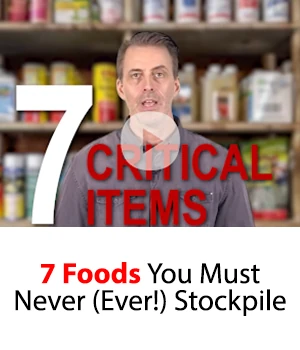A Bug out Bag (BOB) is a special kind of bag used by survivalists to get them out of an emergency situation and enable their self-contained survival for up to 72 hours or 3 days. Since there are so many items you need to survive in an emergency situation and the space available in any Bug Out Bag is minimal, the choice of the gear to include can prove extremely difficult especially for new survivalists.
If you plan well, your BOB can sustain you for much longer than the stipulated 3 days. However, there is a limit to the amount of load you can carry on your back and a 72-hour target is a good place to begin from. Please check out the following 7 types of gear you must have in your Bug Out Bag if you are to mitigate any emergency situations you might experience in the wilderness.
Bug Out Bag Gear
1. Water
Ask any medic and he/she will tell you how vital water is to your well being. Water becomes even more precious in a survival situation. In the bare minimum, each person should have at least one liter of water per day to survive. So for the three days, you need to carry a minimum of 3 liters of water in your BOB.
However, not just any water is safe. Sometimes, you will be required to include a water purification system such as iodine tablets, water boiler or a serious filter (if you can afford one). To make the most out of your BOB, you can use a collapsible water bottle or carry premium quality bottled water since such water is already purified.
A good trick would be to make use of coffee filters to optimize the life and performance of your water filtration system. When it comes to water as a survival gear, there is no compromise. You must carry enough water since you can survive without other gears but not without water.
2. Food
Next to water, the other extremely important gear you must have in your Bug Out Bag is food. Your body needs nourishment to work optimally, something you will need in an emergency situation. Food provides energy and vitality you need to survive in extreme conditions. Think about including backpack meals and energy bars.
Backpack meals are usually dried foods that you just add boiling water to and they are ready to eat. This makes them extremely easy and quick to prepare and therefore great for emergencies. Energy bars, on the other hand, are supplemental bars that contain cereals as well as other high energy foods that target people in need of quick energy but have limited time to allow them to prepare common meals.
Clearly, you will need to prepare better food when you are out there in the wilderness. However, this should not stop you from including special foods like the backpack meals and energy bars mentioned in your Bug Out Bag.
3. Protective Clothing
Depending on where you stay or where you intend to visit, you must carry proper clothing. Because of the differences in weather conditions from one area to another and different seasons in a particular place, there is no one-size-fits-all when it comes to the choice of clothing to have in your BOB.
For instance, you cannot really wear winter garments in a 100 degree summer season and vice versa. Pack appropriate clothing for the weather conditions prevailing in your preferred geographical area. The choice of clothes notwithstanding, it is good to carry some long jeans as well as a decent match of boots.
Other important clothing you need to create space for in your Bag Out Bag includes 2 pairs socks (not necessarily cotton), 2 shirts (a short-sleeved and a long-sleeved shirt for layering), a jacket to serve both as raincoat and body warmer, warm clothing, a and a bandana. These are just the essentials as the list is endless.
4. First Aid Kit
You do not know when you will need to stop a bleeding that could turn catastrophic in an emergency situation. This is where a First Aid Kit becomes important gear to include in your Bug Out Bag. Such kits come in many different sizes and contents. Therefore, you could meet problems in choosing the right size to carry and the contents you will need for survival.
First Aid kits can be expensive gadgets yet they contain stuff you are unlikely to use. So, many survivalists try to go around the cost by building their own homemade First Aid Kits. You can collect few vital components such as sterile gauze dressings, bandages, disposable sterile gloves, cleansing wipes, antibiotics and painkillers, scissors, thermometer, and tweezers.
5. Shelter
Surviving outdoors for up to 3 days can expose you to extreme environmental elements such as extreme cold, heat, and rain. Thus you need some sort of shelter. A good choice would be a backpacking tent. However, a small Bug Out Bag may not have enough space to accommodate such tent. A good alternative would be space blanket. You need to keep in mind that such blankets are only used once. So, for the 3 days, you will need three space blankets.
Alternatively, you can use a tarp while also doubles as a rain collection device. The type of shelter notwithstanding, it must be leak proof and capable of protecting you from the elements. It should also be spacious enough to accommodate your size.
6. Weapon
It may sound inappropriate but you must have some sort of weapon in your BOB if you must survive in an emergency. Consider an out-of-law situation or a situation close to it, your own security could be at risk because people tend to do crazy things. The ability to defend yourself is one of the mindsets a survivalist must have.
Although controversial, a weapon such as a discrete gun would be the best choice. You can choose from any number of survival weapons available but the choice of the one to use is personal. If you do not like guns then a good multipurpose survival knife would be a very good alternative. The bottom line is that you must have the ability to defend yourself in the need arises.
7. Assorted Basic Survival Gear
For lack of strong or collective word, I would refer to a few survival gadgets as assorted basic survival gears and not risk repeating myself. These are gears you cannot operate without if you are in a survival situation yet they do not fall into any of the major categories we have so far described.
Examples of these absolutely necessary gears include fire making kits, firewood, small pot for boiling water for making backpack and energy meals, survival knife, and source of light. You need to find room for each of these gears in your bug out bag.
Conclusion
A Bug Out Bag is one of the most vital items you can have with you if you are a serious survivalist. My hope is that this discussion on the 7 types of gear must have in your Bug Out Bag has answered your questions. You can now pack with confidence knowing that you are covered. If you include these gears, you will most likely successfully survive where others would not.


